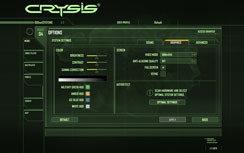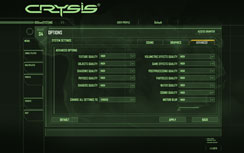BFG Tech GeForce 8800 GTS OC 512MB
Written by Tim Smalley
February 1, 2008 | 07:42
Tags: #512 #512mb #8800 #bfg #bfgtech #card #evaluation #g92 #geforce #gts #oc #overclocked #overclocking #performance #review

Crysis
Publisher: Electronic ArtsWhat can we say about this game that hasn’t been said already? Crysis is probably the most anticipated game on the PC last year and was released on November 16th 2007.
Crysis is seen by many as the poster boy for DirectX 10 and it will make your system cry, quite literally – it’s a monster! It doesn’t come as much of a surprise then, that the graphics are something special – they’re above and beyond anything we’ve ever seen in a PC game.
We tested the game under both DirectX 9.0 and DirectX 10 with the 1.1 patch applied. We used a custom timedemo recorded on the Island map which is more representative of gameplay than the built-in benchmark that renders things much faster than you’re going to experience in game. We found that around 25-30 fps in our timedemo was sufficient enough to obtain a playable frame rate through the game. It’s a little different to other games in that the low frame rates still appear to be quite smooth.
For our testing under DirectX 9.0, we set all of the in-game settings to high, while we set shader quality and water quality to 'very high' for DirectX 10 -- all other settings remained the same as what they were set to for our DX9 performance testing. Because of how intense the game is, we tested with both anti-aliasing and anisotropic filtering disabled at resolutions above 1280x1024 for the time being. There is currently no support for anisotropic filtering in the game, but you can still force it from the driver control panel.
DirectX 9.0
Crysis
1280x1024 2xAA 0xAF, High Quality, DirectX 9.0
- Nvidia GeForce 8800 Ultra 768MB
- BFGTech GeForce 8800 GTS 512MB OC
- ATI Radeon HD 3870 X2 1GB
- Nvidia GeForce 8800 GTS 512MB
- ATI Radeon HD 3870 X2 512MB CrossFire
- Nvidia GeForce 8800 GTX 768MB
- Nvidia GeForce 8800 GT 512MB
- ATI Radeon HD 3870 512MB
-
-
37.0
-
28.0
-
-
-
35.9
-
25.0
-
-
-
35.1
-
24.0
-
-
-
35.1
-
24.0
-
-
-
35.1
-
23.0
-
-
-
33.6
-
25.0
-
-
-
31.6
-
22.0
-
-
-
22.2
-
15.0
-
0
10
20
30
40
Frames Per Second
-
Average
-
Minimum
Crysis
1680x1050 0xAA 0xAF, High Quality, DirectX 9.0
- ATI Radeon HD 3870 X2 512MB CrossFire
- ATI Radeon HD 3870 X2 1GB
- Nvidia GeForce 8800 Ultra 768MB
- BFGTech GeForce 8800 GTS 512MB OC
- Nvidia GeForce 8800 GTS 512MB
- Nvidia GeForce 8800 GTX 768MB
- Nvidia GeForce 8800 GT 512MB
- ATI Radeon HD 3870 512MB
-
-
37.5
-
25.0
-
-
-
37.1
-
26.0
-
-
-
35.1
-
24.0
-
-
-
35.0
-
24.0
-
-
-
34.3
-
23.0
-
-
-
32.2
-
21.0
-
-
-
30.5
-
20.0
-
-
-
25.1
-
17.0
-
0
10
20
30
40
Frames Per Second
-
Average
-
Minimum
Crysis
1920x1200 0xAA 0xAF, High Quality, DirectX 9.0
- ATI Radeon HD 3870 X2 512MB CrossFire
- ATI Radeon HD 3870 X2 1GB
- Nvidia GeForce 8800 Ultra 768MB
- BFGTech GeForce 8800 GTS 512MB OC
- Nvidia GeForce 8800 GTS 512MB
- Nvidia GeForce 8800 GTX 768MB
- Nvidia GeForce 8800 GT 512MB
- ATI Radeon HD 3870 512MB
-
-
32.3
-
21.0
-
-
-
31.9
-
21.0
-
-
-
29.7
-
19.0
-
-
-
29.0
-
19.0
-
-
-
28.4
-
18.0
-
-
-
26.1
-
17.0
-
-
-
25.2
-
16.0
-
-
-
20.8
-
12.0
-
0
5
10
15
20
25
30
35
Frames Per Second
-
Average
-
Minimum
DirectX 10
Crysis
1280x1024 2xAA 0xAF, Very High Water/Shaders, all others High, DirectX 10
- ATI Radeon HD 3870 X2 512MB CrossFire
- ATI Radeon HD 3870 X2 1GB
- Nvidia GeForce 8800 Ultra 768MB
- BFGTech GeForce 8800 GTS 512MB OC
- Nvidia GeForce 8800 GTX 768MB
- Nvidia GeForce 8800 GTS 512MB
- Nvidia GeForce 8800 GT 512MB
- ATI Radeon HD 3870 512MB
-
-
34.5
-
21.0
-
-
-
33.7
-
20.0
-
-
-
32.6
-
23.0
-
-
-
29.7
-
20.0
-
-
-
29.7
-
21.0
-
-
-
29.2
-
20.0
-
-
-
26.5
-
18.0
-
-
-
22.3
-
13.0
-
0
5
10
15
20
25
30
35
Frames Per Second
-
Average
-
Minimum
Crysis
1680x1050 0xAA 0xAF, Very High Water/Shaders, all others High, DirectX 10
- ATI Radeon HD 3870 X2 512MB CrossFire
- ATI Radeon HD 3870 X2 1GB
- Nvidia GeForce 8800 Ultra 768MB
- BFGTech GeForce 8800 GTS 512MB OC
- Nvidia GeForce 8800 GTX 768MB
- Nvidia GeForce 8800 GTS 512MB
- Nvidia GeForce 8800 GT 512MB
- ATI Radeon HD 3870 512MB
-
-
33.8
-
21.0
-
-
-
32.8
-
14.0
-
-
-
30.3
-
19.0
-
-
-
28.1
-
19.0
-
-
-
27.8
-
17.0
-
-
-
27.6
-
18.0
-
-
-
24.5
-
16.0
-
-
-
21.2
-
12.0
-
0
5
10
15
20
25
30
35
Frames Per Second
-
Average
-
Minimum
Crysis
1920x1200 0xAA 0xAF, Very High Water/Shaders, all others High, DirectX 10
- ATI Radeon HD 3870 X2 512MB CrossFire
- ATI Radeon HD 3870 X2 1GB
- Nvidia GeForce 8800 Ultra 768MB
- BFGTech GeForce 8800 GTS 512MB OC
- Nvidia GeForce 8800 GTS 512MB
- Nvidia GeForce 8800 GTX 768MB
- Nvidia GeForce 8800 GT 512MB
- ATI Radeon HD 3870 512MB
-
-
27.5
-
20.0
-
-
-
26.4
-
14.0
-
-
-
24.5
-
15.0
-
-
-
23.2
-
15.0
-
-
-
22.8
-
15.0
-
-
-
22.4
-
14.0
-
-
-
20.2
-
13.0
-
-
-
17.9
-
11.0
-
0
5
10
15
20
25
30
Frames Per Second
-
Average
-
Minimum
For those of you looking to play Crysis under DirectX 9.0, the BFG Tech GeForce 8800 GTS OC 512MB is a fairly close match for our reference-clocked Nvidia GeForce 8800 Ultra---pretty much right the way across the board. That said, the gap between the two widens a little either at high resolutions or with anti-aliasing enabled.
When you move into a DirectX 10 environment, this gap widens even further and BFG Tech's 8800 GTS OC 512MB matches Nvidia's GeForce 8800 GTX performance characteristics much more closely -- there is a fairly constant gap between the GTS 512 and the Ultra. Given that the GeForce 8800 GTS 512MB has more shader horsepower on tap than the 8800 Ultra, one would expect it to be a much better performer than it is, but because of limitations in other areas, the card ends up being a little slower as the load on the GPU's memory bus increases.











Want to comment? Please log in.